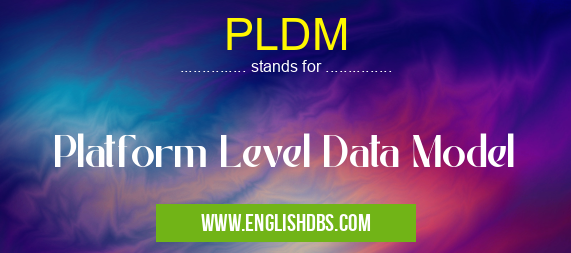What does PLDM mean in HARDWARE
Platform Level Data Model (PLDM) is an industry-standard specification that defines a common data model for platform management information and commands across different hardware platforms. It enables system management software to communicate with and manage platform hardware components in a consistent and standardized manner.

PLDM meaning in Hardware in Computing
PLDM mostly used in an acronym Hardware in Category Computing that means Platform Level Data Model
Shorthand: PLDM,
Full Form: Platform Level Data Model
For more information of "Platform Level Data Model", see the section below.
- PLDM stands for Platform Level Data Model.
- It's a specification that defines a standard way of representing and exchanging data between different components of a computer system.
- PLDM is used in a variety of applications, including server management, power management, and thermal management.
Understanding PLDM
- PLDM defines a common set of data structures and commands that can be used to represent and exchange data between different components of a system.
- This allows different components to communicate with each other in a consistent and reliable manner, even if they are from different vendors or have different architectures.
- PLDM is based on the Intelligent Platform Management Interface (IPMI) specification, which is a widely used industry standard for managing computer systems.
Benefits of PLDM
- Improved system management: PLDM provides a standard way to manage different components of a system, making it easier to monitor and control the system.
- Increased flexibility: PLDM allows different components to be added or removed from a system without having to rewrite the management software.
- Reduced development costs: By using a standard specification, developers can save time and money when developing management software.
Applications of PLDM
- PLDM is used in a variety of applications, including:
- Server management
- Power management
- Thermal management
- Security management
- Asset management
Essential Questions and Answers on Platform Level Data Model in "COMPUTING»HARDWARE"
What is PLDM?
What are the benefits of using PLDM?
PLDM offers several benefits, including:
- Interoperability: Enables management software to work with hardware from multiple vendors, regardless of the underlying hardware architecture or operating system.
- Portability: Simplifies application development by providing a portable framework for interacting with hardware management functions.
- Enhanced management capabilities: Provides a comprehensive set of commands and data structures to manage various platform components, such as power, cooling, security, and health monitoring.
How does PLDM work?
PLDM defines a set of commands and data structures that are used to exchange information between management software and hardware components. The commands are sent over a dedicated management bus, such as IPMI or Redfish, and are processed by the hardware's firmware. The data structures provide a consistent format for representing platform management information.
What are the different types of PLDM commands?
PLDM commands fall into three main categories:
- Get commands: Used to retrieve information about platform components.
- Set commands: Used to modify the configuration or state of platform components.
- Operation commands: Used to perform specific actions, such as power on or off, or reset.
Where is PLDM used?
PLDM is widely used in various computing platforms, including:
- Servers: Manages power, cooling, and health monitoring of servers.
- Storage: Manages storage arrays and disk drives.
- Network equipment: Manages switches, routers, and other network devices.
- Embedded systems: Manages embedded devices in industrial, medical, and automotive applications.
Final Words:
- PLDM is a powerful specification that can be used to improve the management of computer systems.
- By providing a standard way to represent and exchange data, PLDM makes it easier to monitor, control, and troubleshoot systems.
- PLDM is an essential technology for modern data centers and other complex computing environments.
